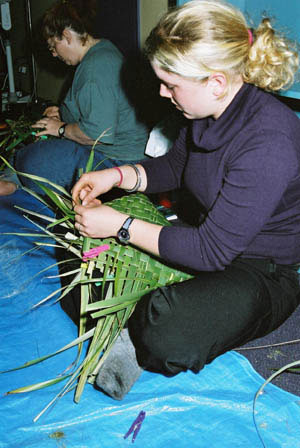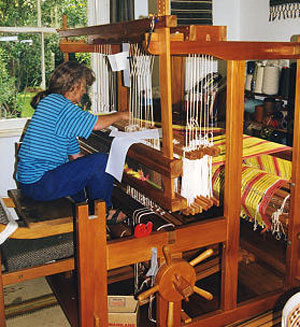Weaver
Tasks & duties

Weavers may do some or all of the following:
-
create weaving designs on paper or using a computer
-
select materials
-
select colours and designs for weaving
-
prepare materials for weaving, such as spinning and dying yarns, collecting and preparing harakeke (flax) by stripping, softening, sizing and dyeing it
-
follow a pattern
-
weave threads into fabric
-
finish fabric
-
make up woven garments from woven cloth if hand-weaving fabrics
-
sell garments, fabrics and other woven items
-
teach weaving
Weavers who use a loom may also:
-
set up, thread and operate the loom
-
adjust the loom to the correct weave setting
-
clean and the maintain the loom
Factory weavers who operate machine looms do not usually create their own designs. Cloth weavers in small companies follow the designs created by others in the group.
Specialisations
Weavers can specialise by working with specific materials such as:
-
cloth
-
wool
-
metal
-
flax
In New Zealand, many weavers specialise in Māori weaving (raranga). Normally using harakeke which is a type of flax, weavers can produce a number of different products such as:
-
kākahu (clothes)
-
whāriki (mats)
-
tāniko (cloaks and capes)
-
tukutuku (wall panels)
-
piupiu (skirts and kilts)
-
kete (baskets)
Weavers who specialise in raranga follow certain procedures and protocols (tikanga) to observe Māori custom and also to acknowledge the beliefs of New Zealand's Māori ancestors.
Skills & knowledge

Weavers need to have:
-
knowledge of different weaving and dyeing methods
-
knowledge of basic weaving structures and how they can be used
-
knowledge of the different materials they can use and how to prepare them
-
awareness of textiles and their properties
-
awareness of styles and trends in weaving
-
skill in operating and maintaining complex looms and weaving equipment
-
design skills
-
small business skills, including marketing and management skills
-
the ability to price their work effectively
Weavers may also need to be skilled in using weaving-related computer software. Some may also need to have pattern-making skills if they are weaving cloth for making garments.
Entry requirements
There are no specific requirements to become a weaver, but skills are gained on the job. Many people start weaving by joining a local community weaving group.
Secondary education
There are no specific secondary requirements, but useful subjects include textiles and design, visual arts and graphics.
Tertiary education
A diploma or degree-level design course may be useful for people wanting to become weavers. A design portfolio must be submitted when applying for entry to these courses.
Training on the job
Weavers gain skills on the job.
The Apparel and Textile ITO offers a National Cerficate which allows people working in the textile industry to gain recognition for skills developed in the workplace.
Useful experience
Useful experience for weavers includes:
-
work in carpet manufacturing
-
carpet or fabric sales work
-
design work
-
work experience in jobs that use machinery
-
weaving courses and hui run by community groups
Courses through weaving groups such as Creative Fibre - the New Zealand Spinning, Weaving and Woolcrafts Society, are also useful.
Related courses
Crafts
Fine Arts
Graphic Arts and Design Studies
Nga Mahi a te Whare Pora (Maori Weaving)
Textile Making
For more information, please refer to Career Services.
Document Actions
